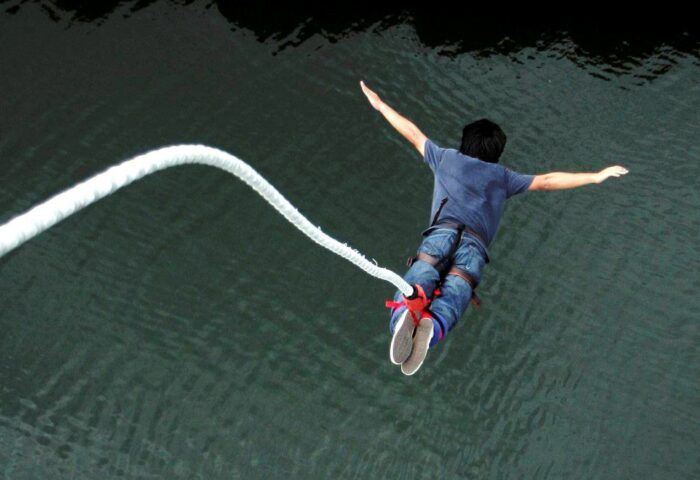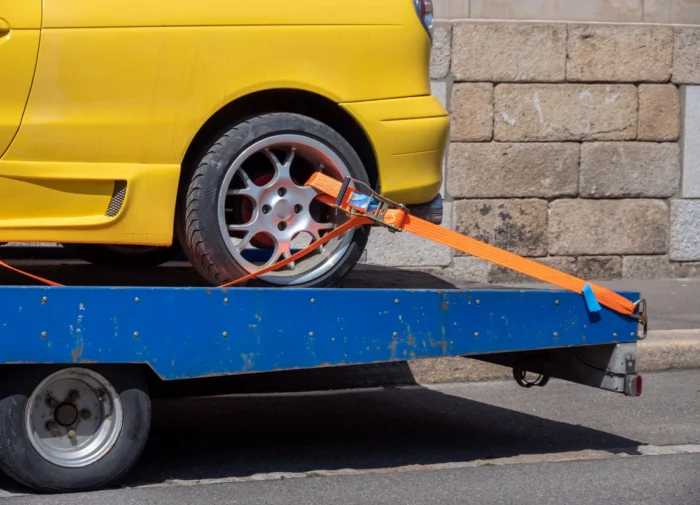Would you agree that every tool has its intended purpose? Of course. You wouldn’t attempt to screw two pieces of wood together using a hammer. You would not try to cut floor tiles with a butter knife. But would you secure luggage to the top of your minivan with bungee cords? I wouldn’t. I would use ratchet or cam straps.
Bungee cords are not for tying things down. They are for jumping from bridges in the pursuit of an adrenaline rush. They are for launching gliders and providing rudimentary suspension for aircraft undercarriages. They were never intended to be used as cargo tie-downs. On the other hand, tie-down straps are designed for that very purpose.
I certainly would not attach a long tie-down strap to my ankles and then jump from a bridge. So why would I throw luggage on top of my car and tie it down with bungee cords?
Launching Gliders From Hilltops

No one is exactly sure where bungee cords originate from. However, the earliest recorded use of the term ‘bungee’ – in relation to the elastic chords we now know by the same name – dates to English glider pilots who used them to launch their gliders in the 1930s. Utilizing bungee cords allowed them to get their aircraft aloft without having to run great distances with a glider on their shoulders.
During WWI, bungee cords proved especially helpful as makeshift suspension systems for planes. They were installed in aircraft undercarriages. Bungee cords even proved ideal for attaching parachutes to people tasked with jumping out of planes and into battle.
One of the prime characteristics that defines the bungee cord is elasticity. Bungee cords are, by design, stretchable. Their holding power rests in the fact that stretching a bungee cord creates tension as the cord tries to return to its natural state. It is a fine principle except for one thing: most bungee cords lose their elasticity over time.
Incidentally, that is one of the reasons bungee cords are really not appropriate as cargo tie-downs. The less elasticity they possess, the less force they can withstand. Expecting an old, worn-out bungee cord to hold valuable cargo securely doesn’t make a lot of sense.
Securing Cargo to Vehicles

Conversely, the tie-down strap has always been meant to be a cargo securement device. Take the ratchet straps that hold things securely on commercial tractor trailers. The straps never had any other purpose. They were not designed to do anything but hold cargo in place.
Ratchet and cam straps alike are made from a webbing material that is usually nylon or canvas. The webbing material sports a very tight weave for exceptional strength and durability. A good ratchet strap will not stretch. It also will not absorb water.
The substantial difference between the two types of straps is how they are secured. A ratchet strap is secured with the device by the same name. You pull the strap through the device and continue ratcheting it until the strap is tight.
A cam strap relies on a cam buckle. You feed the strap through the buckle and pull gently. The strap travels over the cam and is held in place by a spring-loaded plate with teeth. I prefer cam straps, particularly the Rollercam brand.
A Tool for Every Job
The best way to conclude this post is to state the obvious: there is a tool for every job. If your job involves jumping off bridges for entertainment, by all means use bungee cords. But if you are trying to strap cargo to a vehicle, choose tie-down straps instead.





